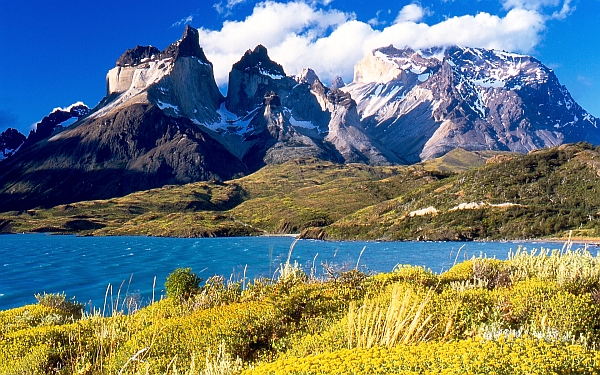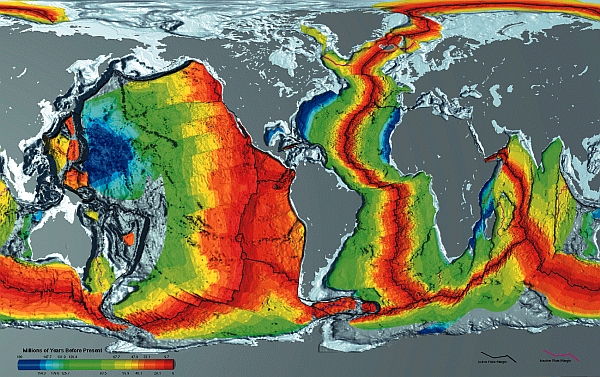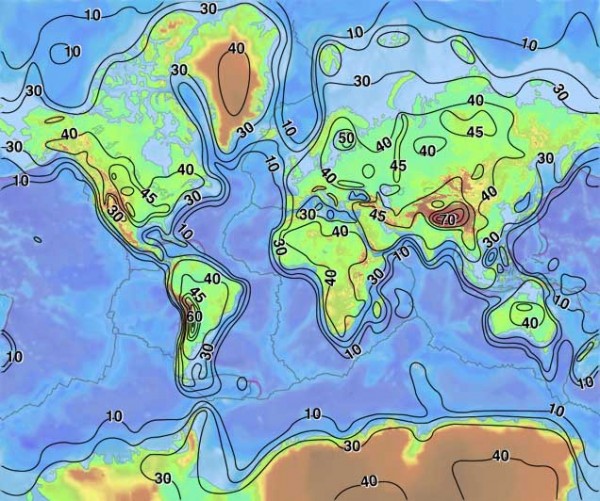Ole Nielsen wrote an interesting post about the world’s highest volcanoes. There are several candidates. Nevados Ojos del Salado and Llullaillaco being the most serious contenders depending on whether we count all of them or only the historically active ones. Which volcano claims the title is not of paramount importance to me. What is interesting is that they are all located in South America. This is nice to know that they are there but so what?

The Andes in Chile. It is considered to be the longest mountain range on Earth (7000 km). Image: Wikipedia.
This is just a mere fact that gives us no further understanding of the mechanisms that allow these volcanoes to become so high. I thought that maybe there are some easy answers in the web but as it usually happens, there are tons of descriptions and trivial facts but very little really useful insight.
So I just tried to collect my pieces of thoughts together and come up with some ideas.
I know that the highest point on the surface of the Earth is the tip of Chimborazo volcano in Ecuador. Some of you may protest that at least yesterday Mt. Everest was higher. Yes, it most likely still is but Chimborazo is the highest point if measured from the center of the Earth. This is so because the Earth’s equatorial radius is longer than its polar radius (the difference is 22 kilometers). Chimborazo is definitely not the highest mountain if measured from the mean sea level (even not in South America) but it is nicely located almost at the equator. Its height from the mean sea level is 6268 meters.
How does that help us answer the question? Well, I just thought that if the volcano is farther away from the center of the Earth, then gravity should be weaker there which makes it easier for the volcano to grow little bit higher. Highest volcano in the Solar System is Olympus Mons. Its height (measured from the base) is 25 kilometers and it is located on Mars where gravity is much weaker that it is here.
We also have to consider the effect of centrifugal force because our Earth is rotating. This force gets stronger as we move higher. So it also helps to counteract the gravitational pull.
The value of gravitational acceleration (which takes into account both factors described above) is 9.78 (m/s2) at the equator and 9.83 at the poles. The difference is there but only about 0.5%. It means that we (and mountains) would weigh about 0.5% more at the poles than at the Equator. That is clearly not enough to explain why the volcanoes in the Andes are so high.
Maybe we have to blame the climate? Atacama desert that is right there next to the highest volcanoes is very dry. Perhaps weathering and erosion are not keeping pace with the uplift as successfully as it is doing in other, more humid regions? I think it might be one part of the answer.
The Andes are on the one hand compressional orogene that is situated at the border of Nazca and South American plates but on the other hand it is also a volcanic range that sits on top of the subduction zone. The highest peaks there are volcanic edifices. Perhaps they are so high because they sit on top of the orogenic belt.
Perhaps the subduction and mountain building in this region is particularly intense which allows the volcanoes to become so high? I don’t have good data for that but the sea floor spreading is very fast in the Southern Pacific, so the subduction should be intense as well.

Sea floor subducting beneath the Andes is young and the spreading in the East Pacific Rise very fast. Image: NOAA.
Maybe the fact that the subduction angle there is very small helps to push the mountain range higher. It is small because the subducting slab is relatively young and therefore more buoyant than older slabs.
Last but not least, Earth’s surface is pushed higher in the regions where the crust is thicker. The crust beneath the Andes is very thick (even 60 kilometers) which is definitely one of the contributing factors.

Earth’s crust beneath the Andes is very thick. Image: USGS.
So I found seven possible contributing factors:
1. Equatorial bulge
2. Centrifugal force
3. Climate
4. Orogene + subduction
5. Intensity of subduction
6. Subduction angle
7. Thickness of the crust
This is a rather complete list but I would like to add the density of the mountain roots as another important factor affecting the hight of the mountains. For example, imagine a cube of ice and a log of dry wood floating in the water. The wood will stand higher out because it is less dense than ice. Because the Earth’s mantle on large timescales behaves like a viscous fluid, the same principle determines the surface topography. In equilibrium conditions the rocks below the depth of 50 km should be transformed to eclogites with average densities of 3.2 g/cm3 but if there is not enough fluids available in lower crust, the facies transition occures very slowly and rocks can stay in granulite facies for a long time even if they are in eclogite conditions. Håkon Austrheim talks a lot about this in his papers regarding Norwegian Caledonides.
Granulites have an average density of 2.9 g/cm3. So if the root is only partly eclogitized it sinks in the mantle less than it would if it would be completely eclogitized and the mountains can be higher.
I do not know is this the case with the Andes, though.
But the principle I descibed is very well explained in this article: http://geology.gsapubs.org/content/32/7/625.abstract.
And this article also talks about the effect of eclogites in the roots of the mountains: http://folk.uio.no/torgeir/pdfpapers/Deweyryanandersen.pdf
It seems that there are article published in Nature few years ago: http://www.nature.com/nature/journal/v446/n7133/full/nature05615.html
Authors seem to think that the width of the subduction zone is the culprit.